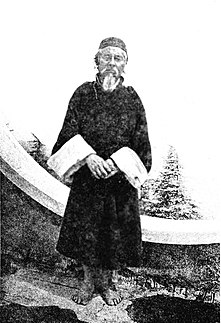Pundit (explorer)
This article needs additional citations for verification. (January 2013) |

The term pundit was used in the second half of the 19th century to denote native Indian surveyors used by the British to secretly explore regions north of
Two of the most famous pundits included the cousins Nain Singh and Kishen Singh (code-named A.K.)[2][3][4]
Great Trigonometric Survey of India
One of the greatest projects of 19th century geography was the
However, in some regions these surveys seemed impossible. Some of the Indian border countries, in particular
Methods
A number of tricks were developed to enable the pundits to make their observations without being found out. They were "trained to walk at precisely two thousand paces to the mile."
The pundits were given extensive training in basic surveying: they learned to use the sextant, determine height by measuring the temperature of boiling water, and make astronomical observations. They also received some medical training. Through their exploration efforts, they managed to bring back vital data that allowed the mapping of areas lying north of India (which were forbidden to Europeans, such as Tibet) with remarkable precision.
Notable pundits
An extensive list of the pundits (and their forerunners) has been detailed chronologically by Michael Ward in the Alpine Journal Volume 103, 1998. (His entry for 1858 is incorrect – Bir and Deb Singh were with William Moorcroft in 1812.)[1] Some notable pundits include:
- Abdul Hamid
- Hari Ram
- Hyder Shah
- Kinthup
- Kishen Singh
- Mirza Shuja
- Nain Singh
- Sarat Chandra Das
In literature
The use of pundits by the British during the Great Game is fictionalized in the 1901 novel Kim by Rudyard Kipling.
See also
- The Great Game
References
- ^ ISBN 978-1-61200-814-1.
- Oxford UniversityPress.
- ^ Derek J. Waller, 2004, "The Pundits: British Exploration of Tibet and Central Asia," University Press of Kentucky.
- ^ Account of the Pundit's Journey in Great Tibet - Capt. H. Trotter, The Journal of the Royal Geographical Society (1877).
- JSTOR 201464.
- ^ OCLC 773021726.
Further reading
- Peter Hopkirk Trespassers on the Roof of the World: The Secret Exploration of Tibet, Tarcher (1 June 1983), hardcover, 274 pages, ISBN 978-0874772579
